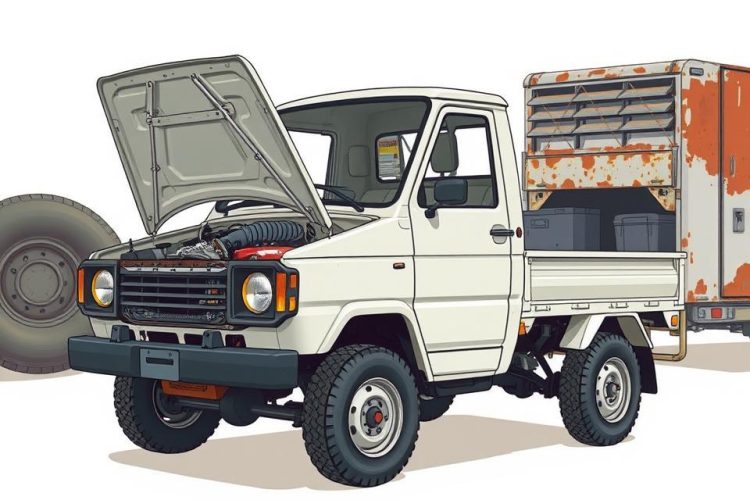Kei trucks are small and versatile. They are popular for many tasks. But, like any vehicle, they can have problems.
These vehicles often face engine, transmission, and electrical system issues. Knowing these problems helps with fixing them.
This article will guide you through common issues. It offers practical solutions for keeping your kei truck in good shape.
Key Takeaways
- Identify common engine problems in kei trucks
- Troubleshoot transmission issues effectively
- Diagnose electrical system faults
- Understand the importance of regular maintenance
- Learn practical repair solutions for common issues
Understanding Kei Trucks and Their Unique Challenges
Kei trucks are different from regular pickup trucks. A kei truck needs special care for maintenance and repair. Known for being small, light, and fuel-efficient, they are popular in Japan and around the world.
What Makes Kei Trucks Different from Standard Pickup Trucks
Kei trucks are made to be efficient and small. Their size and weight help them use less fuel. But, they need special care because of their design.
They have smaller engines and transmissions. These are made for their size and use.
Why Kei Trucks Require Specialized Maintenance Approaches
Kei trucks need special maintenance because of their design. Their engines and transmissions need special tools and skills. Knowing this is key for good maintenance and fixing problems.
Common Misconceptions About Kei Truck Reliability
Some think kei trucks are not reliable because they are small and simple. Others believe their fuel efficiency means they’re not powerful. But, kei trucks are both reliable and fuel-efficient.
Many owners say they have low maintenance costs and last a long time. Understanding kei trucks helps owners and mechanics take better care of them. This ensures they keep working well.
Engine Problems in Kei Trucks
Kei trucks can face engine troubles like hard starting and losing power. These issues can be tough for owners. But knowing why they happen and how to fix them can help a lot.
Hard Starting and Poor Idle Issues
Kei trucks often have trouble starting and idling poorly. This can be because of bad spark plugs, clogged fuel filters, or wrong ignition timing. Keeping up with maintenance, like changing spark plugs and cleaning fuel filters, can stop these problems.
| Cause | Symptoms | Solution |
| Faulty Spark Plugs | Hard starting, poor idle | Replace spark plugs |
| Clogged Fuel Filter | Poor idle, reduced power | Clean or replace fuel filter |
Loss of Power and Performance
Kei trucks losing power and performance can have many reasons. These include clogged air filters, worn piston rings, or broken fuel pumps. Regular checks and upkeep of these parts can bring back the truck’s power.
Unusual Engine Noises and Vibrations
Strange engine sounds and shakes can mean serious problems. These could be worn engine bearings, misaligned engine mounts, or low oil. It’s important to find and fix these issues quickly to avoid more damage.
DIY Fixes vs. When to Seek Professional Help
Some engine troubles can be fixed by yourself, like swapping out spark plugs or cleaning filters. But, more complex issues need a pro. Knowing when to ask for help can save time and keep your kei truck in good shape.
Regular maintenance is key to preventing engine problems in kei trucks.
Transmission and Drivetrain Failures
It’s key to know why kei trucks’ transmissions and drivetrains fail. These problems can make driving hard. They hurt the truck’s performance.
Manual Transmission Grinding and Shifting Problems
Many kei truck owners face grinding and shifting issues. These problems might come from a worn-out clutch or bad synchronizers. Keeping the clutch and synchronizers in good shape helps a lot.
Automatic Transmission Slipping and Hesitation
Slipping and hesitation in automatic transmissions are signs of trouble. Low or dirty transmission fluid can cause these issues. For tips on avoiding transmission problems, check out this guide.
Differential and Transfer Case Issues
Differential and transfer case problems can cause drivetrain failures. Look out for odd noises or vibrations. Regular checks can spot issues early.
Maintenance Tips to Extend Drivetrain Life
- Regularly check transmission fluid levels and condition.
- Inspect clutch components for wear.
- Monitor for unusual noises or vibrations from the drivetrain.
By following these tips, kei truck owners can make their drivetrain last longer. Stay alert to common issues and keep up with maintenance.
Electrical System Troubleshooting
Understanding the electrical system in kei trucks is key. It powers everything from starting the engine to lights and accessories.
Battery Drainage and Starting Problems
Kei truck owners often face battery drainage and starting issues. These can be caused by a drained battery, corroded terminals, or a bad starter.
First, check the battery’s health and charge. Make sure the terminals are clean and tight. If the battery is old or weak, it might need to be replaced.
Lighting and Accessory Failures
Lighting and accessory failures can be caused by blown fuses, bad wiring, or broken parts. Look at the fuse box for any blown fuses and replace them if needed.
Check the wiring for damage or wear. If you find any, fix or replace it. If the problem continues, check the affected parts (like headlights) for damage or malfunction.
Diagnosing Alternator and Starter Issues
The alternator and starter are vital for the electrical system. Finding problems with them needs a careful approach.
For alternator problems, check the belt’s tension and condition, and the electrical connections. A bad alternator can cause battery drainage and other issues.
For starter problems, look at the starter motor and its connections. A worn-out starter might need to be replaced.
Finding Replacement Electrical Parts in the US
Finding the right electrical parts for kei trucks in the US can be hard. They have unique specs. Look for parts from specialty importers or online stores for kei truck owners.
Make sure any parts you get fit your kei truck’s make and model. This will prevent more electrical problems.
Cooling System and Overheating Concerns
Keeping the cooling system in good shape is key for Kei trucks. It stops overheating and keeps the engine running long. Knowing the common cooling system problems helps owners avoid big repairs.
Identifying Causes of Overheating
Many things can make a Kei truck overheat. Low coolant, bad thermostats, and clogged radiators are common culprits. Regular checks can spot these problems early.
Radiator Maintenance and Replacement
The radiator is a big part of the cooling system. Keeping it clean and checking for leaks is important. If it needs to be replaced, make sure it’s the right one.
Water Pump and Thermostat Problems
The water pump and thermostat are key to cooling. A bad water pump means no coolant flow. A faulty thermostat can make the engine too hot or too cold. It’s important to check and replace these parts on time.
Preventing Cooling System Failures
To avoid cooling system problems, regular checks and maintenance are needed. Here are some steps:
- Check coolant levels and add more if needed.
- Look for leaks or damage in the radiator.
- Replace the water pump and thermostat as recommended.
| Component | Maintenance Task | Interval |
| Coolant | Check Level | Monthly |
| Radiator | Inspect for Leaks | Every 6 Months |
| Water Pump | Replace | Every 50,000 Miles |
Suspension and Steering Difficulties
Suspension and steering problems in kei trucks are frustrating and unsafe. They can cause an unstable ride and wear down other parts.
Handling Unstable Ride and Alignment Issues
An unstable ride often comes from bad alignment or worn-out parts. Misaligned wheels wear out tires unevenly. It’s important to check alignment often to keep the ride stable.
Ball Joint and Tie Rod End Failures
Ball joints and tie rod ends are key for steering. If they fail, steering gets loose and noisy. It’s important to check and replace them to keep steering safe.
Leaf Spring and Shock Absorber Problems
Leaf springs and shock absorbers affect how well a kei truck rides. If they’re worn out, the ride gets bumpy. Upgrading them can make the truck ride better.
Upgrading Suspension Components for Better Performance
Upgrading suspension parts can make a kei truck perform better. Check out this resource on lift kits for the Honda Acty. It shows how upgrades can boost your truck’s performance.
Rust and Body Deterioration Solutions
Kei truck owners often face challenges with rust and body deterioration. This can harm the vehicle’s integrity. Rust can shorten a vehicle’s life, mainly in humid or salty areas.
Common Rust Spots on Kei Truck Bodies
Rust often forms in moist areas or where coatings are damaged. Common spots include wheel wells, frames, and suspension parts. Regular checks can spot these problems early.
Preventing Corrosion in Vulnerable Areas
To stop corrosion, keep the vehicle’s coatings in good shape. Make sure the body is clean and apply rust inhibitors. For Kei trucks, clean the underside often, after salt or moisture exposure. For more tips, see this article on rust-proofing.
DIY Rust Repair Techniques
Fixing rust early can stop bigger problems. DIY repair means cleaning, removing rust, and applying a converter or coating. Always wear safety gear and follow safety rules.
Protective Coatings and Treatments
Using protective coatings can help your Kei truck’s body last longer. You can use wax, undercoating, or rust inhibitors. These keep corrosion away and need to be reapplied to stay effective.
Fuel System and Carburetor Issues in Kei Trucks
The fuel system and carburetor in kei trucks are key parts. When they don’t work right, big problems can happen. These issues can make the truck run poorly, use more fuel, and even stop working.
Fuel Delivery Problems and Poor Fuel Economy
Problems with fuel delivery in kei trucks can come from clogged filters, bad fuel pumps, or faulty injectors. This can make the truck use more fuel. Keeping the fuel filter clean or replacing it can help.
Carburetor Cleaning and Adjustment
The carburetor mixes air and fuel for the engine in older kei trucks. It can get clogged over time, causing trouble. Cleaning and adjusting the carburetor can fix this and make the truck run better.
Fuel Pump Failures and Replacements
Fuel pump failure is common in kei trucks. It’s often due to wear and tear or fuel system contamination. Getting a new fuel pump can solve the problem and prevent more issues.
Converting to Alternative Fuels
Some people choose to make their kei trucks run on LPG or biofuels. This can save money and help the environment. But, it’s important to do it right and safely.
| Issue | Cause | Solution |
| Poor Fuel Economy | Clogged Fuel Filter | Replace Fuel Filter |
| Fuel Delivery Problems | Faulty Fuel Pump | Replace Fuel Pump |
| Carburetor Issues | Clogged Carburetor | Clean or Rebuild Carburetor |
Keeping Your Kei Truck Running Strong for Years to Come
Regular maintenance is key for your kei truck’s long life and good performance. A routine check-up helps spot problems early. This keeps your truck running smoothly and efficiently.
Fixing issues quickly and using the right maintenance methods is important. This includes regular oil changes and tire rotations. It also means fixing problems right away. This way, you avoid big repairs later on.
To keep your kei truck in top shape, don’t forget about maintenance. It boosts performance and helps your truck last longer. By following the tips in this article and keeping up with maintenance, you can enjoy your truck for many years.

